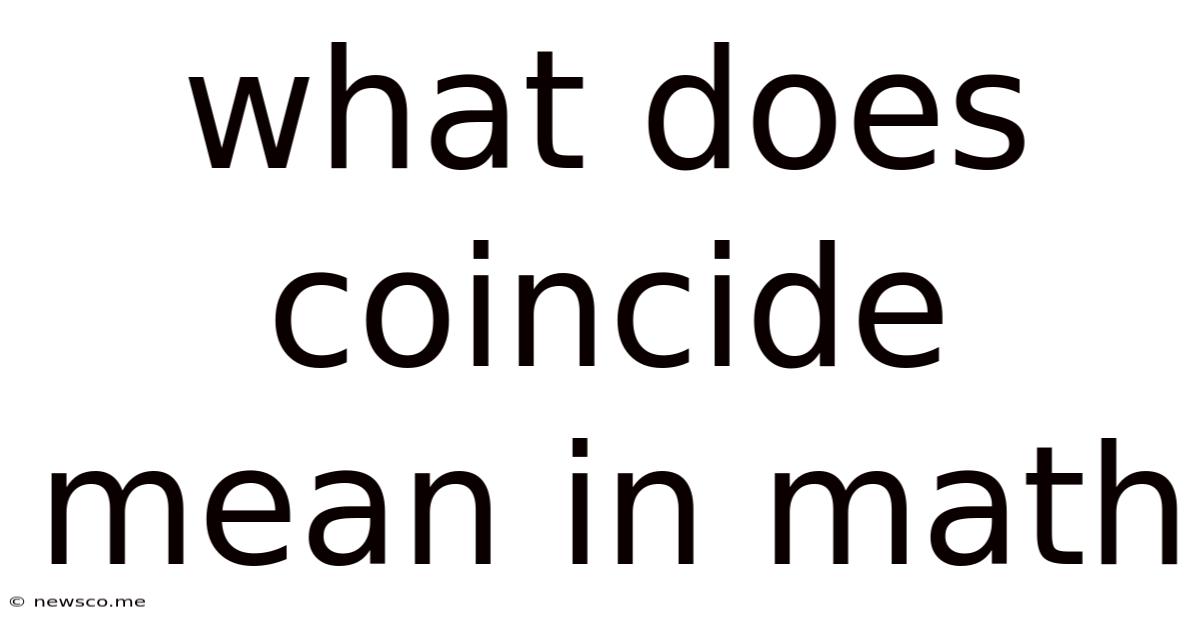What Does Coincide Mean In Math
News Co
Apr 19, 2025 · 5 min read

Table of Contents
What Does Coincidence Mean in Math? Exploring the Concept of Concurrent Events and Simultaneous Occurrences
In mathematics, the word "coincide" doesn't refer to a mere chance happening or a surprising similarity, as it might in everyday conversation. Instead, it possesses a precise and geometrical meaning, deeply rooted in the concepts of concurrent events and simultaneous occurrences. Understanding "coincidence" in mathematics requires delving into the intersection of lines, planes, and figures, exploring the properties of overlapping geometries and the implications for various mathematical fields.
Understanding Coincidence in Geometry: The Intersection of Lines and Planes
At its core, coincidence in mathematics signifies the exact overlapping of geometric objects. This means that two or more lines, planes, or figures occupy precisely the same space. They are not simply near each other; they are identical in their location and extent.
Coincident Lines
Two lines are said to coincide if they share all their points. This implies that they are essentially the same line, just possibly represented by different equations. Consider two lines defined by the following equations:
- Line 1: y = 2x + 1
- Line 2: y = 2x + 1
These lines are coincident. No matter what value of 'x' you choose, the corresponding 'y' value will be identical for both lines. They lie directly on top of each other. Graphically, you would only see a single line.
However, if even one point differs, the lines are not coincident. For example:
- Line 1: y = 2x + 1
- Line 2: y = 2x + 2
These lines are parallel; they never intersect. The difference in the y-intercept signifies a distinct separation.
Coincident Planes
Similarly, two planes coincide if they share all their points. Imagine two sheets of paper perfectly aligned – they are coincident planes. Their equations would be algebraically equivalent, reflecting their complete overlap. Again, any discrepancy in their defining equations would indicate distinct, non-coincident planes, possibly intersecting at a line or remaining parallel.
Coincident Figures
The concept extends beyond lines and planes to more complex geometric figures. Two circles are coincident if they have the same center and radius. Two triangles are coincident if their corresponding vertices and sides perfectly overlap. In general, any two geometric figures coincide if one can be superimposed exactly onto the other without any adjustments or transformations.
Coincidence in Other Mathematical Contexts
While the geometric interpretation is central, the idea of coincidence subtly appears in other areas of mathematics:
Simultaneous Equations
In algebra, systems of simultaneous equations can exhibit coincidence. Consider this system:
- x + y = 3
- 2x + 2y = 6
These equations are equivalent; one is simply a multiple of the other. They represent coincident lines, and there are infinitely many solutions (any point on the line x + y = 3 satisfies both equations). This contrasts with systems having a unique solution (intersecting lines) or no solutions (parallel lines).
Set Theory
In set theory, two sets are coincident (or equal) if they contain exactly the same elements. This reflects the fundamental idea of overlapping objects, but now applied to collections of elements rather than geometric figures. {1, 2, 3} and {3, 1, 2} are coincident sets despite the different ordering of elements.
Functions
In calculus and analysis, two functions are coincident on an interval if they have identical values for all points within that interval. This isn’t necessarily true for their entire domain; they may differ outside the interval of coincidence.
Distinguishing Coincidence from Other Mathematical Relationships
It's crucial to differentiate coincidence from related but distinct mathematical concepts:
-
Intersection: Two geometric objects intersect if they share at least one point. Coincidence implies intersection, but intersection doesn't necessarily imply coincidence. Intersecting lines share one point, while coincident lines share all points.
-
Parallelism: Parallel lines or planes never intersect. They are distinctly separate, unlike coincident objects.
-
Congruence: Congruent figures have the same size and shape, but they might be located at different positions. Coincident figures are congruent, but congruent figures are not necessarily coincident.
-
Similarity: Similar figures have the same shape but potentially different sizes. Coincidence implies similarity (with a scaling factor of 1), but similarity doesn't imply coincidence.
Practical Applications of Coincidence
Understanding the concept of coincidence isn't merely an academic exercise. It finds applications in various fields:
-
Computer Graphics: In computer-aided design (CAD) and computer graphics, determining whether two objects coincide is crucial for collision detection, object merging, and other modeling tasks.
-
Robotics: Path planning in robotics involves checking for coincidences between the robot's trajectory and obstacles to prevent collisions.
-
Physics: In classical mechanics, coincident points might represent the collision of particles.
-
Mapping and Surveying: Coincidence of lines or points on maps is crucial for accuracy and consistency in geographic information systems (GIS).
Conclusion: The Significance of Coincidence in Mathematical Precision
In conclusion, the mathematical meaning of "coincide" goes beyond everyday usage. It signifies precise overlapping and identical location of geometric objects or sets. It’s a fundamental concept with profound implications for various branches of mathematics and its applications in science, engineering, and technology. By grasping its nuances and distinguishing it from related concepts, we can more accurately describe and analyze geometric relationships and solve problems requiring the precise identification of overlapping elements. The understanding of coincidence enhances our ability to model reality with greater precision and sophistication. It underscores the importance of clear definitions and precise language in the pursuit of mathematical understanding. The seemingly simple concept of coincidence, therefore, unlocks a wealth of possibilities in the world of mathematical exploration and its practical applications.
Latest Posts
Related Post
Thank you for visiting our website which covers about What Does Coincide Mean In Math . We hope the information provided has been useful to you. Feel free to contact us if you have any questions or need further assistance. See you next time and don't miss to bookmark.